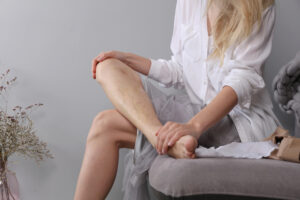Varicose Veins vs. Spider Veins: Spotting the Difference
Take a close look at your legs. Do you notice any prominent veins? This is completely normal, but one question remains—is it varicose or spider veins? Learn what these conditions are, the differences between them, and the available treatments.
What are Varicose Veins?
 Varicose veins are large, bulgy, and rope-like. They appear swollen and raised above the skin’s surface, often bluish-purple in color. They’re most commonly seen on the lower legs and often cause uncomfortable symptoms, from aching pain and a sense of heaviness to itching and skin ulcers.
Varicose veins are large, bulgy, and rope-like. They appear swollen and raised above the skin’s surface, often bluish-purple in color. They’re most commonly seen on the lower legs and often cause uncomfortable symptoms, from aching pain and a sense of heaviness to itching and skin ulcers.
The key culprit behind varicose veins is a condition called venous insufficiency. This occurs when the one-way valves in your veins become weak or damaged, causing blood to pool and the veins to swell. But don’t worry—varicose vein treatments have advanced greatly in recent years, with modern solutions being less invasive and more effective than ever.
What are Spider Veins?
Spider veins are smaller are more delicate than varicose veins. They look like thin, web-like networks of red or blue veins tracing along the skin’s surface. They often appear on the legs and face. While they don’t cause the same discomfort as varicose veins, their appearance may be embarrassing.
The causes of spider veins are varied and include hormonal shifts, sun exposure, injuries, and aging. Unlike varicose veins, they aren’t usually a cause for concern, but spider vein treatment offers important cosmetic benefits.
Effective Treatments for Varicose Veins and Spider Veins
Whether you determine you have varicose veins or spider veins, the good news is that treatments are available for both conditions. These include:
- Endovenous Laser Therapy (EVLT): EVLT uses laser energy to target and collapse faulty varicose veins from the inside. Laser treatment can also be used for spider veins, particularly those on the face. The collapsed vein shrinks and eventually dissolves, allowing the body to reroute blood flow to healthier veins for improved circulation.
- Sclerotherapy: This treatment is commonly used for both spider veins and small varicose veins. It involves injecting a solution directly into the problematic vein. This solution irritates the vein’s lining, causing it to swell, collapse, and eventually close off. Over time, the treated vein fades away. As with EVLT, the blood reroutes to healthier veins, improving circulation.
- Phlebectomy: Also known as vein stripping, a phlebectomy is a surgical procedure that removes varicose veins through small incisions in the skin. It’s typically reserved for large veins that don’t respond to conservative treatments.
Why Choose Arizona Vein and Laser Institute?
Now that you understand varicose veins vs. spider veins, the next step is choosing the proper care. Arizona Vein and Laser Institute is a leader in the vein treatment field. Our surgeons provide the highest standards of compassionate care, using advanced technology to restore your veins to full health and improve your quality of life. We offer comprehensive, personalized treatment plans to ensure you receive the best care possible. Contact us today to schedule a consultation at one of our six Phoenix-area locations.
